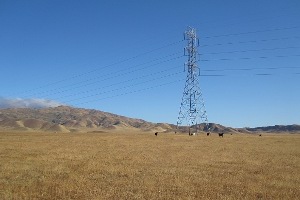KISSACK: Kim Williams moved to the tranquil Panoche Valley about four years ago from the Bay Area to run an organic egg business called Your Family Farm.
[Sound of Williams talking to her hens]
WILLIAMS: When you travel around California there are not many valleys that you say I am stepping back into time, this is amazing.
KISSACK: Panoche Valley's unique landscape also turns out to be rich in wildlife. The valley floor is teaming with creatures, some of them endangered like the San Joaquin kit fox, and the blunt nose leopard lizard. More than 130 species of birds have also been observed in the area, including bald eagles. Looking out at the project site, Brandon Hill, President of the Fresno Audubon Society, says the valley has too much biodiversity for a big solar plant.
HILL: When you are taking up four thousand acres plus you are basically destroying the habitat, much of it is under panels or converted into roads and it is going to drastically change the habitat out there.
KISSACK: To find out just what is out there Solargen's investors have spent over seven million dollars to gather information for a required Environmental Impact Report. More than twenty biologists have spent much of the past year searching out every fox den on the project site, canvassing creek beds and geo-tagging lizard scat.
KORPOS: Does anyone have an anemometer to measure the wind?
KISSACK: Today, in high winds, wildlife biologist Michelle Korpos leads her team through a barbed wire fence and onto an adjacent parcel called "mitigation land" - about eleven thousand acres that Solargen would set aside for wildlife to offset the impact of the project.
KORPOS: Presumably the species can disperse from the site because the mitigation lands are contiguous to the site. And the larger mammals like the kit fox and badger, they can make their way over the hills into little Panoche valley which offers greater biodiversity and topography.
KISSACK: These biologists are taking a multispecies conservation approach - which could speed up the permitting process. The San Joaquin kit fox, for example, thrives in grazing areas and if it can do well in the mitigation lands, it's assumed so can other grassland species. But not everyone agrees. In fact, local environmentalists are concerned that the surveys are being rushed to meet the deadline to qualify for federal tax credits. Chicken farmer Kim Williams says she is all for solar -- just not big arrays.
WILLIAMS: You could do smaller solar fields around cities as well as utilizing all rooftops and shade and parking areas and bus stops.
KISSACK: Energy analysts say California can't meet its clean power goals without big solar farms and that line of thinking has some surprising supporters.
BOYLE: There are a few of us who have been working very closely with the generators and increasingly with the state and federal regulators trying to find a pathway through these conflicts.
KISSACK: Barbara Boyle oversees clean energy solutions for the Sierra Club. She thinks the :us vs. them" approach that has helped win a lot of environmental debates, in the past, needs to change when it comes to siting clean energy projects.
BOYLE: We also need to get out there and identify where are the good places for solar and wind to go so they know when they invest hundreds of millions of dollars in their proposals they are going to a place that has a high probability of getting permitted.
KISSACK: In the Panoche Valley Charlie McCullough steps out of his modest home and looks over the hills behind him. He and his brother are among the ranching families that have agreed to sell land to Solargen, in his case, for several million dollars.
MCCOLLOUGH: Everybody in the valley is mad at us for bringing the solar in. I'm going to hate to see a bunch of panels out there, too but I know that we have to have solar. If you can't have it here, you can't have it anywhere.
KISSACK: The San Benito County Board of supervisors is expected to vote on the project before the end of the year. To see a map of solar intensity throughout the U.S, go to KQED.org/33x20. I'm Andrea Kissack, KQED Public Radio.
 A plan that requires California's utilities to generate one third of their electricity from solar and other types of clean energy by 2020 has been held up by a glacially slow permitting process due, in part, to controversies over where to build big, renewable projects.
A plan that requires California's utilities to generate one third of their electricity from solar and other types of clean energy by 2020 has been held up by a glacially slow permitting process due, in part, to controversies over where to build big, renewable projects.